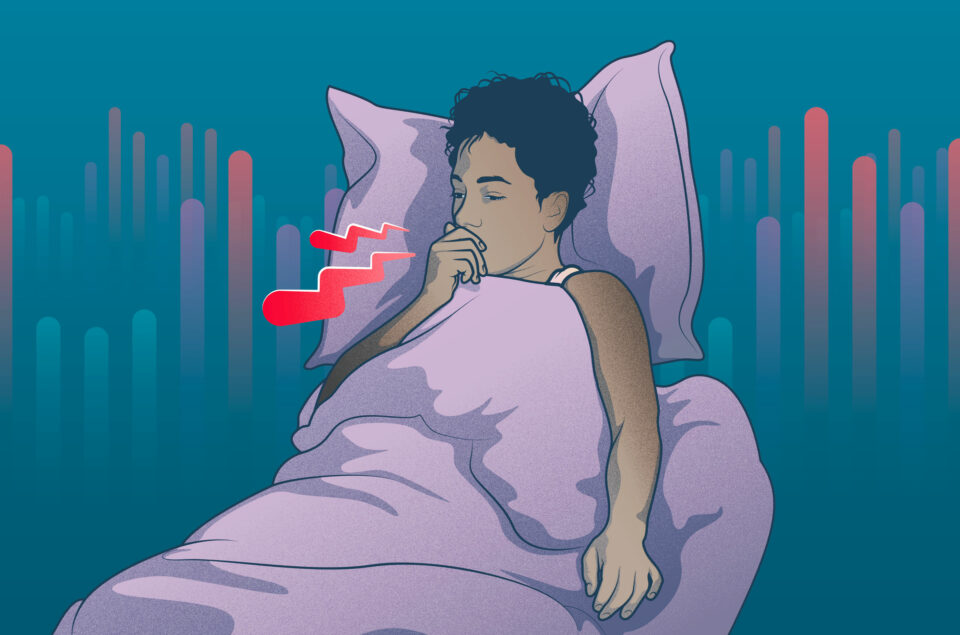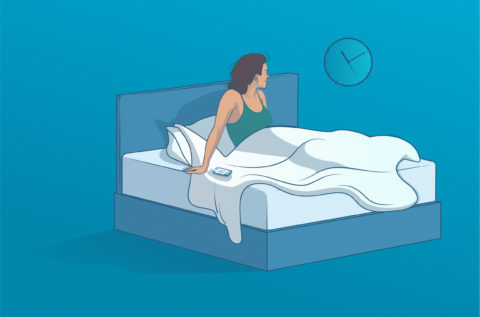If you’re a new parent, you’re probably no stranger to sleepless nights. Getting a baby to sleep can be a challenge, but there are many techniques and tools that parents can use to help their little ones get the rest they need. One such tool that has gained popularity in recent years is white noise – a type of sound that is created by combining different frequencies, resulting in consistent, soothing background noise. Many parents swear by the use of white noise for baby sleep, but is it really effective?
Start tracking your baby’s sleep with Sleep Cycle Kids
In this article, we’ll take a closer look at the benefits of white noise for baby sleep, how to give it a try, and what to consider while using it.
- What’s white noise?
- Is white noise good for babies?
- 5 tips on how to use white noise with babies
- Summary FAQs
What is white noise?
White noise is a type of sound that contains all frequencies at equal levels, creating a uniform hum that can mask other sounds in the environment. It is often described as a “hissing” or “static” sound, similar to the sound of a TV or radio tuned to an unused channel, that masks and blocks out other sounds that may be disruptive to sleep, relaxation, or concentration, such as traffic, neighbors or other background noises.
It is a popular tool for helping people fall asleep and stay asleep, and some parents also confirm it helps soothe and relax their babies. Babies have immature nervous systems that can be easily overstimulated by new sounds and sensations. White noise can help create a predictable and consistent sleep environment, which can contribute to regulating a baby’s sleep-wake cycle and improve the overall quality of their sleep.
Is white noise good for babies?
Although more exhaustive research is needed to find out the efficacy of white noise in babies’ and toddlers’ sleep, some studies have begun to uncover benefits for babies’ sleep, including:
- A possible calming effect on fussy or colicky babies: The soothing hum of white noise can have a calming effect on babies who are fussy or colicky, as it can help distract them from feelings of discomfort and overstimulation. This can help both the baby and the caregiver feel more relaxed and centered.
- Helping babies fall asleep faster: White noise creates a soothing sleep environment that can help lull babies to sleep more quickly. By masking other sounds, it can also help prevent babies from being disturbed or awakened as they fall asleep. Additionally, it’s important to note that the American Academy of Pediatrics (AAP) recommends that babies sleep in a quiet, dark, and cool room, without any additional noise or light.
- Reducing the frequency and duration of night wakings: White noise can help prevent babies from waking up by other sounds, such as traffic outside or a noisy pet. . Resulting in babies that are more likely to sleep through the night or wake up less frequently and then only for short periods of time.
- Improving sleep quality for both babies and parents: As white noise can help babies sleep better, it can lead to improved sleep for parents as well, who will be less likely to be woken up by an unhappy baby.
- Helping establish a consistent sleep routine: Incorporating white noise into a baby’s sleep routine can help signal to them that it is time to sleep. This can be especially helpful for babies who are struggling to establish a consistent sleep pattern, as the familiar sound can help them recognize when it’s time to fall asleep.
How to use white noise with babies: 5 main tips
While white noise can be a helpful tool for promoting better sleep in babies – in particular, those suffering from colics – it’s important to use it safely and appropriately. It should be used as a tool to aid sleep, rather than as a substitute for other important sleep practices such as safe sleeping positions and regular sleep schedules. Moreover, always speak to your baby’s pediatrician for further advice based on your baby’s specific sleep needs.
- Choose a high-quality white noise app that is designed specifically for babies: look for an app that produces a consistent, soothing sound that is designed specifically for babies. The Sleep Cycle app contains a sound library with a range of different sounds to choose from. However, Sleep Cycle kids will soon include sounds more targeted to your baby, such as heartbeat, ocean waves, and lullabies.
- Play white noise about 20 inches away from the baby, ideally across the room: Ensure there’s ample space between the phone or speaker and the baby’s crib to prevent any potential hazards, yet close enough so the baby can still hear the sound. Place it across the room from the crib, or use a speaker that can be directed away from the baby’s sleeping area.
- Set the volume to a safe level (around 50-60 decibels): the volume should be set at a safe level that is not too loud for the baby’s delicate ears. A good rule of thumb is to set the volume at a level that is no louder than a soft shower. It’s also recommended to keep the volume consistent throughout the night to prevent any sudden, jarring changes in sound that could wake up the baby.
- Keep it as a regular part of their sleep routine – nap times as well as bedtimes: Incorporate the sound into the baby’s sleep routine, playing it for a few minutes before nap time and bedtime. This consistency will help the baby recognize the sound as a cue for sleep.
- Consider using a timer function to automatically turn off the white noise after a set period of time: While some parents prefer to leave the white noise machine on all night, others may prefer to have it turned off after a certain period of time. Many apps come with a timer function that can be set to automatically turn off the white noise after a set period of time. This can help the baby learn to fall asleep without the need for constant noise to stay asleep.
Some precautions and considerations
Trying white noise as a sleep aid should be done with caution and consideration. Remember to always monitor the baby’s response to the white noise to ensure that it is not causing any distress or overstimulation. If the baby seems uncomfortable or agitated by the sound, it may be best to try a different one or to stop using it and try other sleep-promoting techniques. While some research has found that white noise can benefit many babies, the reality is that not all babies will respond well to it or respond at all.
In addition, it’s important to be cautious when using white noise for babies as some studies have shown that excessive, prolonged exposure to loud white noise could lead to hearing damage. While there is no conclusive evidence that white noise directly causes hearing loss, parents should use it with care. As mentioned, the AAP recommends keeping the volume at a maximum of 50 decibels and placing the speaker at a safe distance from the baby’s crib.
Finally, ensure your baby can still fall asleep and stay asleep without any background sound. No matter how useful white noise is, keep in mind those situations when the sound may not be available – a night at the grandparents, a nap at daycare, or while sleeping on a plane. To avoid creating reliance, parents should gradually decrease the volume of the white noise over time and eventually phase it out so the baby gets more used to sleeping without it.
Sleep soundly, little one: Trying white noise to help your baby get better sleep
White noise can be a helpful tool for sleep-deprived parents trying to improve their baby’s sleep or whilst establishing a helpful sleep routine. By creating a consistent sleep environment and drowning out other noises, white noise can help babies fall asleep faster and sleep more soundly, in particular those that show signs of colic. However, it’s important to use it safely and responsibly and to monitor the baby’s response to ensure that it is helping rather than hindering their sleep. With some gentle trial and error, you may find that white noise could be the key to a good night’s sleep for the whole family.
Summary FAQs
Is white noise bad for babies?
White noise is generally safe for babies and can even help them sleep better by creating a soothing environment. It also has a possible calming effect on fussy or colicky babies.
How loud should white noise be for a baby?
The American Academy of Pediatrics recommends keeping white noise for babies below 60 decibels and at a distance of at least 20 inches (50 cm) from their sleeping area.
When to stop using white noise for babies?
It’s recommended to always monitor your baby’s response to the white noise to ensure that it is not causing any distress or overstimulation. If the baby seems uncomfortable or agitated by the sound, it may be best to try a different one or to stop using it and try other sleep-promoting techniques.
How to use white noise for babies?
White noise should be used as a tool to aid sleep, rather than as a substitute for other important sleep practices such as safe sleeping positions and regular sleep schedules. Play white noise about 20 inches away from the baby and set the volume to a safe level (below 60 decibels).









